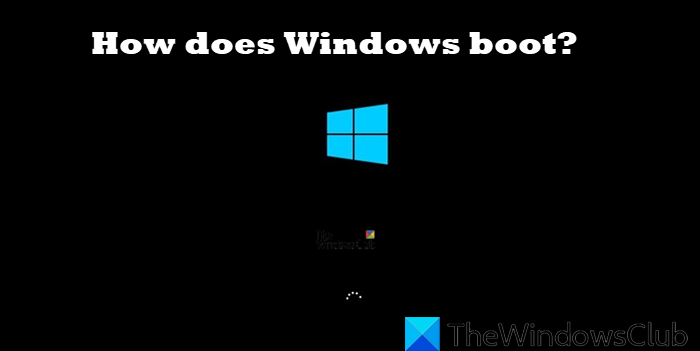Ever wondered what happens when you push the power button? In this post, we will see how Windows OS boots and all that goes behind in the background. While all we see it as one process, everything happens in steps. It has been designed in such a fashion that if you face any issue with Windows Boot, you will be able to troubleshoot it.

How does Windows 11 boot
Windows boot process on BIOS systems comprises of four major phases. It starts from POST and ends up loading the Windows OS Loader or the Kernel. Here is a detailed description of the Windows 10 boot process and the list of stages it goes through:
- PreBoot
- Windows Boot Manager
- Windows OS Loader.
- Windows NT OS Kernel.
During every process, a program is loaded. Depending on whether it uses Legacy BIOS or UEFI, the file paths and files change.
| Phase | Boot Process | BIOS | UEFI |
| 1 | PreBoot | MBR/PBR (Bootstrap Code) | UEFI Firmware |
| 2 | Windows Boot Manager | %SystemDrive%\bootmgr | \EFI\Microsoft\Boot\bootmgfw.efi |
| 3 | Windows OS Loader | %SystemRoot%\system32\winload.exe | %SystemRoot%\system32\winload.efi |
| 4 | Windows NT OS Kernel | %SystemRoot%\system32\ntoskrnl.exe |
1] PreBoot: POST or Power-On Self-Test loads firmware settings. It checks for a valid disk system, and if the system is good to go for the next phase. If the computer has a valid MBR, i.e., Master Boot Record, the boot process moves further and loads Windows Boot Manager.
2] Windows Boot Manager: This step determines if you have multiple OS installed on your computer. If yes, then it offers a menu with the names of the OSs. When you select the OS, it will load the right program, i.e., Winload.exe to boot you into the correct OS.
3] Windows OS Loader: Like its name, WinLoad.exe loads important drivers to kick start the Windows Kernel. The kernel uses the drivers to talk to the hardware and do rest of the things required for the boot process to continue.
4] Windows NT OS Kernel: This is the last stage that picks up the Registry settings, additional drivers, etc. Once that has been read, the control is taken by the system manager process. It loads up the UI, the rest of the hardware and software. That’s when you finally get to see your Windows 10 Login screen.
When you run Windows 11/10 on a computer that supports Unified Extensible Firmware Interface (UEFI), Trusted Boot protects your computer from the moment you power it on. When the computer starts, it first finds the operating system bootloader. Computers without Secured Boot simply run whatever bootloader is on the PC’s hard drive.
When a computer equipped with UEFI starts, it first verifies that the firmware is digitally signed. If Secure Boot is enabled, the firmware examines the bootloader’s digital signature to verify that it is intact hasn’t been modified. You can read more on how to secure the Windows Boot Process.
Do remember that many things happen even after you log in, but those are all post-boot process scenarios. Also note that there is much more to the Windows 11/10 Boot process than we explained here—we only explained the basics!